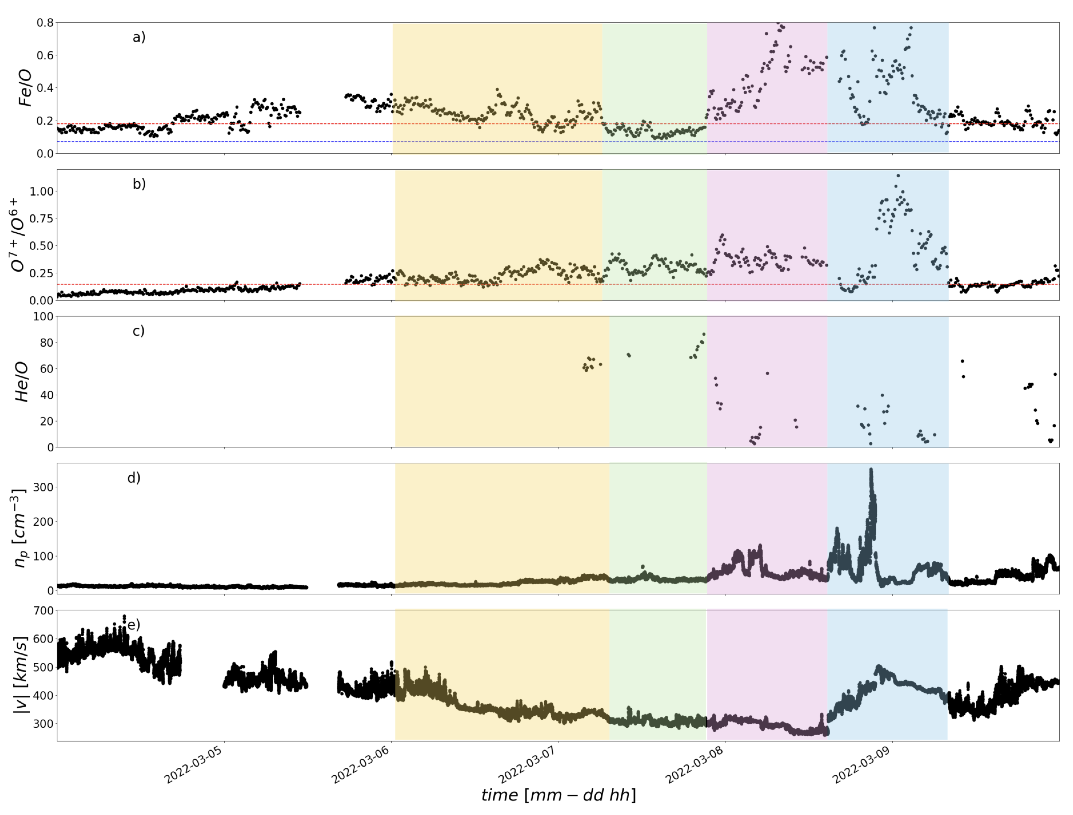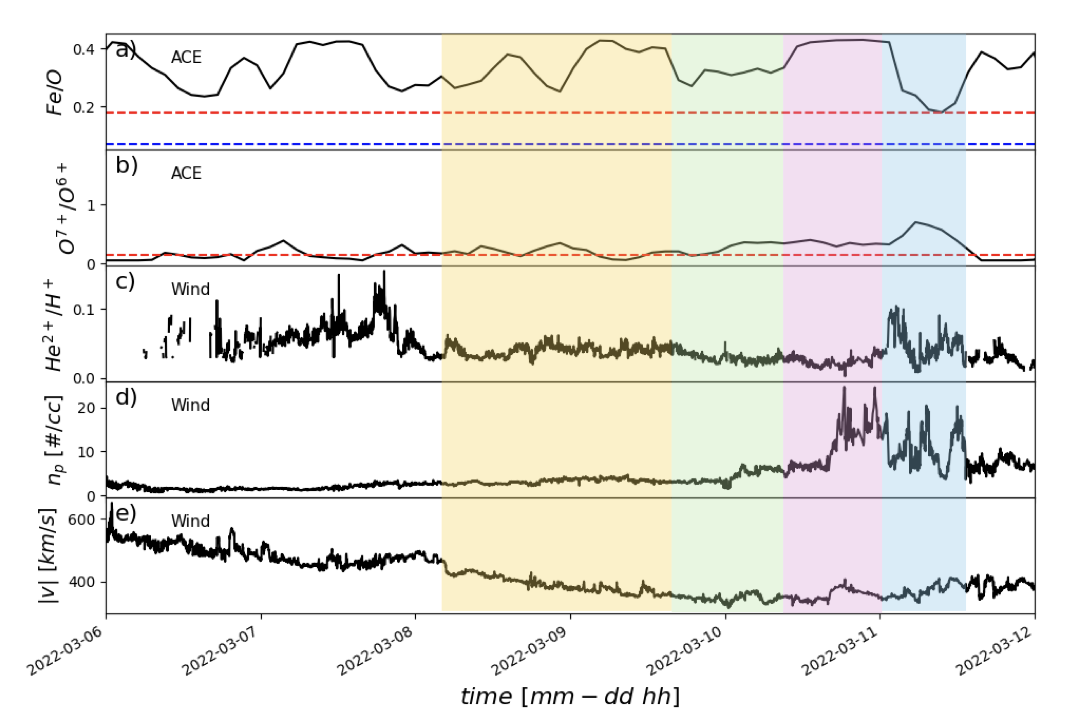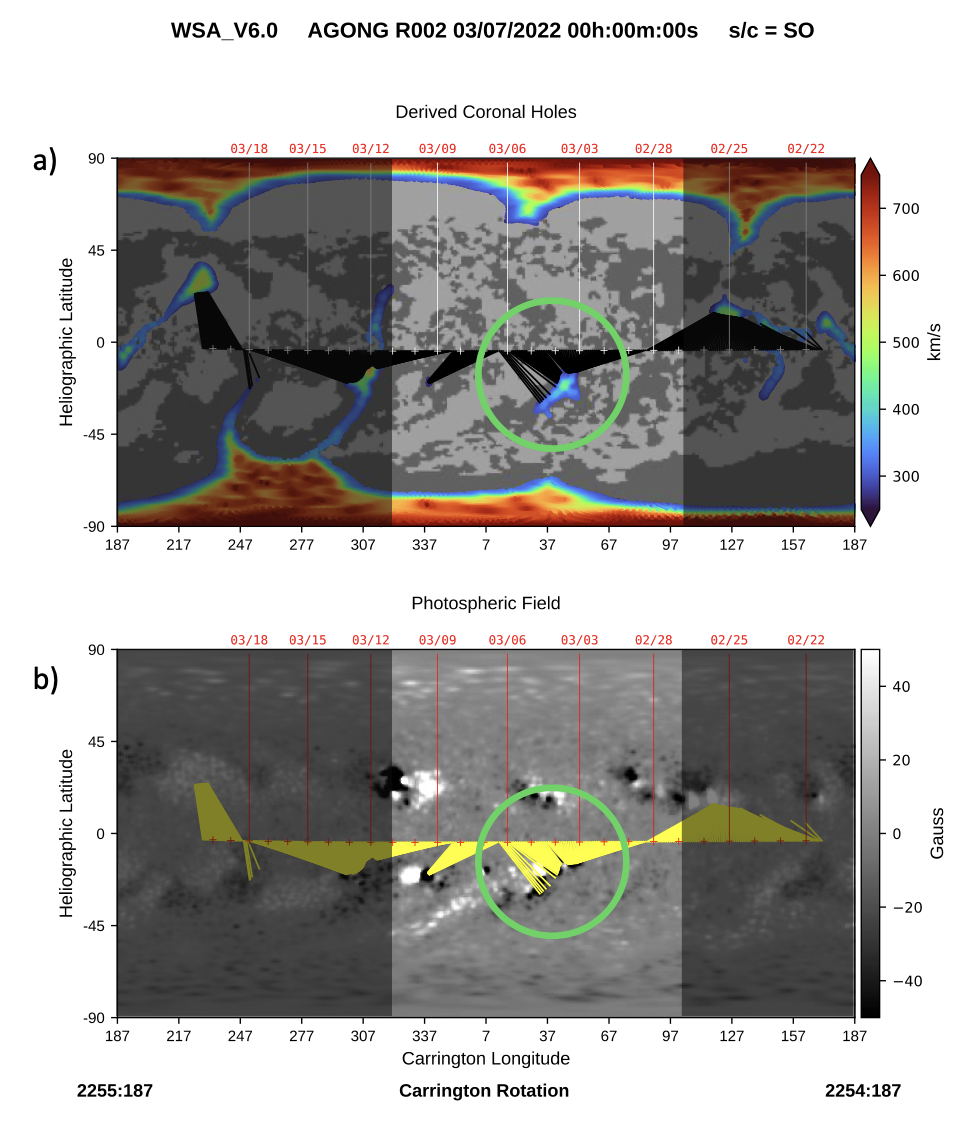Science nugget: Connecting Solar Orbiter and L1 measurements of mesoscale solar wind structures to their coronal source using the Adapt-WSA model - Solar Orbiter
Connecting Solar Orbiter and L1 measurements of mesoscale solar wind structures to their coronal source using the ADAPT-WSA model
(Solar Orbiter Nugget #38 by Samantha Wallace1, Natalia Zambrana Prado2, Irena Gershkovich3, Nicholeen Viall4, Peter Young4, Therese A. Kucera4, Susan T. Lepri2, Stephanie Yardley5, and the Solar Orbiter/SWA team)
Introduction
Mesoscale structures are important tracers of solar wind formation because they retain signatures of their heating at their low coronal source, their release, and their acceleration through the high corona [1]. A key observable to investigate the formation of mesoscale structures is the plasma's heavy ion composition and charge states. These properties are determined within ~5 Rs and are preserved as the solar wind advects through the heliosphere [2-4], allowing us to infer the source region of in situ solar wind measurements. In particular, active regions and quiet Sun magnetic fields (observed remotely) exhibit elevated abundances ratios of elements with low first ionization potential or FIP (e.g. Fe) to those with high FIP (e.g. O), and higher charge states compared to coronal holes [3]. The solar wind from these sources is released through magnetic reconnection at the solar open-closed boundary [5]. It is highly structured on mesoscales and at times quasi-periodic. Solar Orbiter’s (SO) unique combination of remote and in situ instruments enables scientific investigation into the formation of the mesoscale structures in the solar wind, specifically by using plasma composition as a diagnostic tool. Linking the properties of solar wind parcels observed in situ to their source region at the Sun observed remotely is an ongoing challenge in heliophysics, that is better enabled by coronal and solar wind modeling.
In this work, we investigate a several-day interval from 4 March, 2022 00:00:00 UT to 9 March, 2022 23:59:59 UT in which Solar Orbiter’s Heavy Ion Sensor (HIS) [6] observed mesoscale solar wind structures identified in composition measurements. During this interval, SO was at ~0.49 AU and in near-radial alignment with Earth, allowing us to confirm that these structures survive to L1. We also employ a well-established spectral analysis method [7] that identifies periodic signals in physical time series, to determine whether any of the mesoscale structures observed in Fe/O and O7+/O6+ are periodic in nature. We use the Wang-Sheeley Arge (WSA) model [8-10] driven by synchronic Air Force Data Assimilative Photospheric Flux Transport (ADAPT) model maps [11-13] to connect in situ measurements during this interval to their sources at the Sun. We characterize the source region of this event with model determined parameters that are empirically related to solar wind speed, and/or proxies for how the solar wind is formed. When possible, we determine the S/O FIP bias observed remotely in SPectral Imaging of the Coronal Environment (SPICE) [14] rasters, at the model-determined locations and times that are the sources of the in situ observed solar wind parcels. We then compare the Fe/O FIP bias derived from in situ HIS measurements, with the corresponding S/O FIP bias derived by SPICE at WSA-determined solar source region, to investigate how these mesoscale structures were formed. The combination of available observations and modeling for this period make it the ideal candidate to answer science questions regarding mesoscale solar wind structures, including their sources and survival through the inner heliosphere.
Observations and Modeling of the Solar Wind Source Region

Figure 1: SO/HIS observations for 4 March 2022 00:00:00 UT to 09 March 2022 23:59:59 UT. a) Fe/O abundance, with average reference values of 0.059 for the photosphere in blue [15], and 0.17 for the corona in red [16]. b) O7+/O6+, with a reference value of 0.145 in red [17]. c) He/O abundance. d) Proton number density (cm-3). e) Solar wind bulk speed (km s-1).
Figures 1 and 2 show the in situ analysis of this event in both SO/HIS observations and L1 measurements from ACE and Wind. Colored regions highlight mesoscale structures delineated by Fe/O variability first observed at SO, and again at L1 ~2 days later. It is important to note that while the Fe/O abundance observed at SO does not always precisely match that observed at L1, the variability and structure boundaries in these measurements are preserved (outlined in shaded regions). This train of structures was identified at L1 via a simple estimate of the solar wind parcel's transit time from the Sun to 1 AU assuming the average speed in each shaded region. A notable feature in Fig. 2 is the small SIR observed at 15:00 UT on 8 March (at magenta/blue boundary in Fig. 1), preceded by a steady decrease in solar wind speed from moderately fast speeds (~550-600 km s-1) down to <300 km/s. This same trend and SIR is observed at L1 with the exception of only a small velocity enhancement at 21:00 UT on 10 March. Enhancements observed in Fe/O and O7+/O6+ on ~21:00 UT 8 March are concomitant with peak density and velocity measurements associated with the small SIR. The spectral analysis results (not shown here) confirm that quasi-periodic mesoscale structures in the 0.6 – 0.7 mHz range (~30-minute periodicities) are present in O7+/O6+ observations for 4 of the 6 days we investigate.

Figure 2: ACE and Wind observations for 6 March 2022 00:00:00 UT to 11 March 2022 23:59:59 UT. a) Fe/O abundance, with average reference values of 0.059 for the photosphere in blue [15], and 0.17 for the corona in red [16]. b)O7+/O6+, with a reference value of 0.145 in red [17]. c) alpha to proton ratio. d) Proton number density (cm-3). e) Solar wind bulk speed (km s-1).
Figure 3 summarizes the ADAPT-WSA output for the model-determined source region of this event. SO is magnetically connected to a mid-latitude coronal hole of negative polarity, formed alongside a network of three active regions (Fig. 3 at ~37 deg Carrington longitude, or CL). This coronal hole is isolated in a largely unipolar region formed from an inclined HCS, which is common during periods of high solar activity. On 6 March 2024 08:00:00 UT at the Sun; 8 March, 2022 15:00:00 UT in situ at SO, the spacecraft connectivity changes to a separate region of open field of the same polarity that borders a compact and well-defined active region (Fig. 3, 337 deg CL). This connectivity change coincides with the small SIR observed in situ. Further analysis in our paper (in prep) characterizes the source region of this event with model determined parameters that are empirically related to solar wind speed, and/or proxies for how the solar wind is formed (i.e., expansion factor, squashing factor, coronal hole boundary distance).

Figure 3: WSA model output derived with an ADAPT-GONG synchronic photospheric field map for 7 March 2022 00:00:00 UT, which is the timestamp of the last magnetogram assimilated into this map. All panels are shaded to highlight the portion of WSA output that was derived with the most recent magnetogram data included in the ADAPT map, thus showing the most reliable model output for this Carrington rotation (CR). White (a) or red (b) tick-marks label the sub-satellite points, represent the heliographic location of SO in time mapped to 5 Rs with dates labeled above in red. The timestamps associated with the sub-satellite points correspond to when the solar wind left the Sun, as opposed to when it arrived at SO ~2-3 days later. Black (a) or yellow (b) straight lines connect the projection of SO’s location at 5 Rs to the solar wind source region at 1 Rs. a) WSA-derived open field at 1 Rs with model-derived solar wind speed in colorscale. The field polarity at the photosphere is indicated by the light/dark (positive/negative) gray contours. b) Synchronic ADAPT-GONG photospheric field (Gauss) for 7 March 2022 00:00:00 UT.
Conclusion
This analysis successfully tracks mesoscale structures observed in Fe/O composition measurements from their active region source at the Sun, to SO in situ measurements at 0.49 AU, and finally to L1. The presence of mesoscale periodic structures in the heavy ion composition observed by SO/HIS is consistent with the observed plasma originating from an active region, as determined by the ADAPT-WSA mapping. The fact that these structures were present in in situ solar wind composition measurements means they formed at the Sun and survived through the inner heliosphere. The variation of the plasma composition on the order of minutes to hours suggests that interchange reconnection was responsible for the release of these structures into the solar wind. Relating the FIP bias observed in the solar wind to that derived by SPICE measurements is still ongoing in this study. It is uniquely challenging as the FIP biases obtained from remote and in situ observations are derived from different abundance ratios (i.e. HIS solar wind measurements of Fe/O, and SPICE remote observations of S/O). This work demonstrates what can be accomplished by combining multi-messenger observations from instruments distributed throughout the heliosphere with physics- and empirical-based modeling. The study also demonstrates how these measurements could be improved and coordinated for future missions, to maximize the synergy between these types of techniques.
This work is in preparation for publication.
Affiliations
1 Department of Physical Sciences, Embry-Riddle Aeronautical University, Daytona Beach, FL
2 Mullard Space Science Laboratory, University College London, Holmbury St. Mary, UK
3 University of Michigan, Ann Arbor, MI, USA
4 NASA Goddard Space Flight Center, Greenbelt, MD, USA
5 Northumbria University, Newcastle, UK
References
[1] Viall, N.M., et al. (2021). Mesoscale Structure in the Solar Wind. Frontiers in Astronomy and Space Sciences. (10.3389/fspas.2021.735034)
[2] Landi E., et al. (2012). Charge state evolution in the solar wind. II. Plasma charge state composition in the inner corona and accelerating fast solar wind. ApJ.
(10.1088/0004-637X/744/2/100)
[3] Laming J.M. (2015). The FIP and Inverse FIP Effects in Solar and Stellar Coronae. Living Reviews in Solar Physics. (10.1007/lrsp-2015-2)
[4] Laming J.M., et al. (2019). Element abundances: A new diagnostic for the solar wind. ApJ. (10.3847/1538-4357/ab23f1)
[5] Vial N.M. & Borovsky J.E. (2020). Nine outstanding questions of solar wind physics. JGR: Space Physics. (10.1029/2018JA026005)
[6] Livi, S., et al. (2023). First results from the Solar Orbiter Heavy Ion Sensor. A&A. (10.1051/0004-6361/202346304)
[7] Di Matteo S., et al. (2021). Power Spectral Density Background Estimate and Signal Detection via the Multitaper Method. Journal of Geophysical Research: Space Physics. (10.1029/2020JA02874810.1002/essoar.10502619.2)
[8] Arge C.N., et al. (2000). Improvement in the prediction of solar wind conditions using near‐real time solar magnetic field updates. Journal of Geophysical Research: Space Physics. (10.1029/1999JA000262)
[9] Arge C.N., et al. (2003). Improved Method for Specifying Solar Wind Speed Near the Sun. Solar Wind Ten. (10.1063/1.1618574)
[10] Arge C.N., et al. (2004). Stream structure and coronal sources of the solar wind during the May 12th, 1997 CME. J. Atmos. Solar-Terr. Phys. (10.1016/j.jastp.2004.03.018)
[11] Arge C.N., et al. (2010). Air Force Data Assimilative Photospheric Flux Transport (ADAPT) Model. Solar Wind 12. (10.1063/1.3395870)
[12] Arge C.N., et al. (2011). Improving Data Drivers for Coronal and Solar Wind Models. Astron. Soc. Pacific
[13] Arge C.N., et al. (2013). Modeling the corona and solar wind using ADAPT maps that include far-side observations. Solar Wind 13 (10.1063/1.4810977)
[14] Anderson, M., et al. (2020). The Solar Orbiter SPICE instrument - An extreme UV imaging spectrometer. A&A. (10.1051/0004-6361/201935574)
[15] Asplund M., et al. (2021). The chemical make-up of the Sun: A 2020 vision.
Astronomy & Astrophysics. (10.1051/0004-6361/202140445)
[16] Schmelz J.T., et al. (2012). Composition of the Solar Corona, Solar Wind, and Solar Energetic Particles. The Astrophysical Journal. (10.1088/0004-637X/755/1/33)
[17] Zhao L., et al. (2009). Global distribution of the solar wind during solar cycle 23: ACE observations. Geophysical Research Letters. (10.1029/2009GL039181)
- Removed a total of (3) style margin:0;
Nuggets archive
2025
19/03/2025: Radial dependence of solar energetic particle peak fluxes and fluences
12/03/2025: Analysis of solar eruptions deflecting in the low corona
05/03/2025: Propagation of particles inside a magnetic cloud: Solar Orbiter insights
19/02/2025: Rotation motions and signatures of the Alfvén waves in a fan-spine topology
12/02/2025: 'Sun'day everyday: 2 years of Solar Orbiter science nuggets that shed light on some of our star's mysteries
22/01/2025: Velocity field in the solar granulation from two-vantage points
15/01/2025: First joint X-ray solar microflare observations with NuSTAR and Solar Orbiter/STIX
2024
18/12/2024: Shocks in tandem : Solar Orbiter observes a fully formed forward-reverse shock pair in the inner heliosphere
11/12/2024: High-energy insights from an escaping coronal mass ejection
04/12/2024: Investigation of Venus plasma tail using the Solar Orbiter, Parker Solar Probe and Bepi Colombo flybys
27/11/2024: Testing the Flux Expansion Factor – Solar Wind Speed Relation with Solar Orbiter data
20/11/2024:The role of small scale EUV brightenings in the quiet Sun coronal heating
13/11/2024: Improved Insights from the Suprathermal Ion Spectrograph on Solar Orbiter
30/10/2024: Temporally resolved Type III solar radio bursts in the frequency range 3-13 MHz
23/10/2024: Resolving proton and alpha beams for improved understanding of plasma kinetics: SWA-PAS observations
25/09/2024: All microflares that accelerate electrons to high-energies are rooted in sunspots
25/09/2024: Connecting Solar Orbiter and L1 measurements of mesoscale solar wind structures to their coronal source using the Adapt-WSA model
18/09/2024: Modelling the global structure of a coronal mass ejection observed by Solar Orbiter and Parker Solar Probe
28/08/2024: Coordinated observations with the Swedish 1m Solar Telescope and Solar Orbiter
21/08/2024: Multi-source connectivity drives heliospheric solar wind variability
14/08/2024: Composition Mosaics from March 2022
19/06/2024: Coordinated Coronal and Heliospheric Observations During the 2024 Total Solar Eclipse
22/05/2024: Real time space weather prediction with Solar Orbiter
15/05/2024: Hard X ray and microwave pulsations: a signature of the flare energy release process
01/02/2024: Relativistic electrons accelerated by an interplanetary shock wave
11/01/2024: Modelling Two Consecutive Energetic Storm Particle Events observed by Solar Orbiter
2023
14/12/2023: Understanding STIX hard X-ray source motions using field extrapolations
16/11/2023: EUI data reveal a "steady" mode of coronal heating
09/11/2023: A new solution to the ambiguity problem
02/11/2023: Solar Orbiter and Parker Solar Probe jointly take a step forward in understanding coronal heating
25/10/2023: Observations of mini coronal dimmings caused by small-scale eruptions in the quiet Sun
18/10/2023: Fleeting small-scale surface magnetic fields build the quiet-Sun corona
27/09/2023: Solar Orbiter reveals non-field-aligned solar wind proton beams and its role in wave growth activities
20/09/2023: Polarisation of decayless kink oscillations of solar coronal loops
23/08/2023: A sharp EUI and SPICE look into the EUV variability and fine-scale structure associated with coronal rain
02/08/2023: Solar Flare Hard Xrays from the anchor points of an eruptive filament
28/06/2023: 3He-rich solar energetic particle events observed close to the Sun on Solar Orbiter
14/06/2023: Observational Evidence of S-web Source of Slow Solar Wind
31/05/2023: An interesting interplanetary shock
24/05/2023: High-resolution imaging of coronal mass ejections from SoloHI
17/05/2023: Direct assessment of far-side helioseismology using SO/PHI magnetograms
10/05/2023: Measuring the nascent solar wind outflow velocities via the doppler dimming technique
26/04/2023: Imaging and spectroscopic observations of EUV brightenings using SPICE and EUI on board Solar Orbiter
19/04/2023: Hot X-ray onset observations in solar flares with Solar Orbiter/STIX
12/04/2023: Multi-scale structure and composition of ICME prominence material from the Solar Wind Analyser suite
22/03/2023: Langmuir waves associated with magnetic holes in the solar wind
15/03/2023: Radial dependence of the peak intensity of solar energetic electron events in the inner heliosphere
08/03/2023: New insights about EUV brightenings in the quiet sun corona from the Extreme Ultraviolet Imager








































 Sign in
Sign in
 Science & Technology
Science & Technology